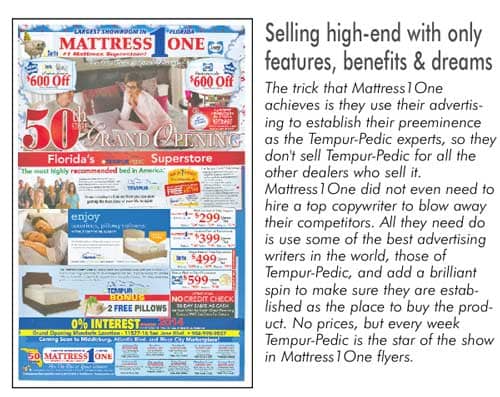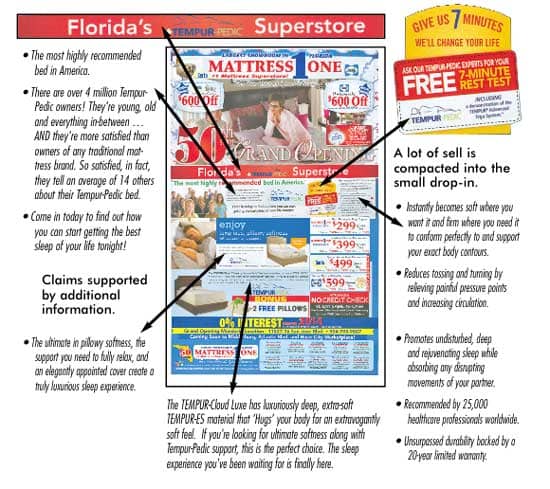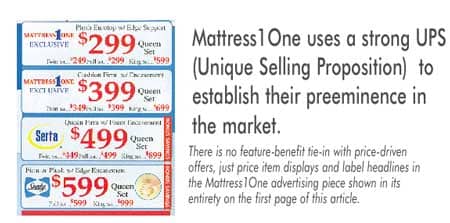How do you translate the power of national mattress branding into retail sales?
Marketing Techniques by Larry Mullins
“Let me tell you Larry. Sealy and Simmons are very concerned about the growing percentage of our high end mattress business that is going to Tempur-Pedic. Very concerned.” This was a comment made by a very strong mattress retailer in the Midwest speaking to me recently.
Should these mattress giants be concerned? Some say that Sealy and Simmons have lost the high ground. The high-end ground, that is. There was a time when Sealy Posturepedic and Simmons Beautyrest were synonymous with mainstream high end bedding. There was a time when retailers did not use prices to advertise Posturepedic and Beautyrest. No one discounted the products. Now the mainstream customer interested in a high end mattress often thinks Tempur-Pedic. Now it’s Tempur-Pedic prices that are not advertised and products that are not discounted.
How did this happen? Tempur-Pedic’s emergence and branding power did not happen overnight. In fact, the “modern revolutionary, space age” product has been lolling around in plain sight for nearly twenty years. It is a good product, to be sure. But Tempur-Pedic is not a revolutionary new product, it is rather a modern miracle in brilliant marketing. Tempur-Pedic did not defeat Simmons Beautyrest and Sealy Posturepedic who are still fighting it out in the tactical, blood-red ocean of mattress wars. Tempur-Pedic made them irrelevant to a certain consumer demographic by defining and branding for itself an uncontested, strategic Blue Ocean with virtually no competition. How did Tempur-Pedic do this?
The answer to that question is the theme of this article. This answer is most important to the independent retailer who wants to understand and profit big time from this revolution. Wrapped up in Tempur-Pedic’s grand strategy are many of the simple principles that can lift a struggling home furnishings business wise enough to adopt them to new levels of success. These principles include Blue Ocean strategy and the concept of branding with a killer USP, a Unique Selling Proposition. The smart independent retailers who master this style of strategic thinking will likely be standing when this period of uncertainty and recession ends.

I’ve written about Blue Ocean strategy at length and will not reprise it here. (See Furniture World articles from August 2006 http://bit.ly/g0PfDa and September 2006 http://bit.ly/ebOYOi. Suffice to say that Blue Ocean is about using your time and imagination to create uncontested market space that will make the big boxes and other competitors irrelevant. Blue Ocean is based upon a study of 150 strategic moves spanning more than 100 years and 30 different industries. According to this study, a heroic branding success can only be sustained if the company continues to innovate. Historic turnarounds and revolutionary strategic coups all followed a repeatable Blue Ocean pattern. Once you understand the pattern, you can apply Blue Ocean strategies to your business with repeatable success.
Great branding begins with a great product. Next comes marketing with a killer USP (Unique Selling Proposition). This opens an inlet into a Blue Ocean of opportunity. Then there is a relentless, consistent process of promotion until the brand is integrated into the public psyche. But, hold on! Don’t other major bedding brands have great products? Aren’t their national ads powerful? Didn’t they once dominate the mainstream high end market with their own powerful USPs? How did they lose ground?
Beautyrest Breaks Into a Blue Ocean
Simmons Beautyrest introduced the revolutionary pocketed coils springs in 1925 and enjoyed a Blue Ocean advantage for quite a while. Simmons acquired endorsements from Henry Ford, Thomas Edison and Eleanor Roosevelt. Movie star Dorothy Lamour praised the virtues of sleeping on Pocketed Coil springs. Startling ads featured circus elephants on a Beautyrest in the 50s. The famous bowling ball ad of 1995 presaged Tempur-Pedic’s later wine glass demonstration of how the product eliminated motion transfer. But, there was little dramatic innovation for the product. Sealy Posturepedic began to capture market share.
A competitor from Sealy, Texas
Sealy mattresses started back in 1881 when a cotton gin builder filled a request for a cotton filled mattress. More requests came in and eventually the owner developed several patents, including a machine that compressed cotton. He sold his patents fifteen years later to a Texas Company that retained the brand name of Sealy. Not long after, an advertising slogan created national attention: “Sleeping on a Sealy is like sleeping on a cloud.” Sealy weathered the Great Depression, and they even managed to innovate a new product idea–an innerspring mattress with a smooth, Button-Free top. Most recently, Sealy has added progressive latex and memory foams to their sleep surfaces. They have now introduced “Individually Wrapped” coils, and have added titanium coils. These are certainly not Blue Ocean innovations, but with broader distribution, Sealy has the edge over Beautyrest in market share.
Bottom line:
Simmons Beautyrest and Sealy Posturepedic produce fine products. Both do a good job in national advertising. Their presence on Facebook and Sealy’s targeted social networking initiative are a definite plus. The jury is still out on Sealy’s new advertising campaign designed to reach the younger generation. Sealy’s use of slightly naughty phrases like “Whatever you do in bed, Sealy supports it” and “It’s better on springs” are perhaps cute and entertaining for some tastes, but will they sell mattresses? And, could phrases like these be used in a retail sales presentation? Personally, I believe most women, even younger ones, prefer phrases like Beautyrest’s: “Togetherness is optional.” Regardless, from my perspective, Tempur-Pedic need not be concerned. We will now explore why their Blue Ocean status is safe.
Tempur-Pedic discovers its USP and Blue Ocean
Tempur-Pedic marketing is not very entertaining. It is not really hip. But Tempur-Pedic does three things that its competitors do not.
Tempur-Pedic uses tried and true evidence-based advertising methods consistently and with great skill. On their website, in their TV commercials, in their print, their mailings, in everything they do they are driven by a consistent and relentless consumer-based strategy. Investing in a mattress is serious business. Customers come into stores pre-sold, and loaded with catch words and phrases like: “space age” “NASA” “no pressure points” “no motion transfer” and on and on. As a result, more and more mainstream customers perceive Tempur-Pedic as the high end bed that will provide them the best sleep.

Tempur-Pedic’s USP is clear and unswerving: “We completely did away with traditional springs in our mattresses in favor of a radical new material that was generally unknown at the time. We work hard to ensure our pricing is consistent no matter where you buy, so you’re not pressured to buy only for a cheap price. Tempur-Pedic is the most recommended bed in America. We warranty all of our larger products because it’s the right thing to do (and because we know they’ll last a long time).”
There you have it. Tempur-Pedic eliminated the springs. The implication is that other companies attempt to copy them by padding with “memory foam,” while Tempur-Pedic “spent years perfecting a NASA® invention into TEMPUR material.”
They even have an elaborate comparison chart on their website showing how superior TEMPUR material is to the old-fashioned memory foam. Finally, they use “risk reversal” with the most liberal warranty in the business. Lots of buzz words and lots of information for the better educated, higher income prospect. On request they will mail you a free kit showing the benefits of sleeping on a Tempur-Pedic mattress, with a certificate good for a free 90 night in-home tryout and a sample of TEMPUR pressure-relieving material.
Perhaps most important of all, Tempur-Pedics’s unique marketing dynamics trickle down to the Retail level. Retail Salespersons use the Tempur-Pedic buzz words. Print advertising often uses the Tempur-Pedic’s carefully crafted copy. For example, Florida based retailer Mattress1One consistently advertises “all the famous brands”–Tempur-Pedic, Sealy, Stearns and Foster, Serta, Restonic, and Therapedic. The people at Mattress1One are smart marketers. They make separate appeals to the low end price prospect and the mainstream high end prospect in their flyers. [Note: When I researched this article, a very astute sales manager told me that today’s customer is generally either price-driven or quality-driven, there is very little in between. He said you may get a price-driven customer to step up a notch or two. However, the old idea of putting a price-driven customer on a high end mattress before taking them to the advertised low end product is no longer working. In his judgment, the middle of the road bedding prospect has virtually vanished in his market.]

The most intriguing thing to me about the Mattress1One approach, however, is the fact that they use very little product information and virtually not a word of benefit copy for their price-driven products (and this includes Sealy Posturepedic, Simmons Beautyrest and Serta Perfect Sleeper). On the other hand, for Sealy’s Stearns and Foster and Embody they use some product information and benefits, but no prices, only coupons with discounts in dollar amounts (not percentages). However, the star of the Mattress1One show is Tempur-Pedic. This is true every week, and this is where they really capture the higher-end customer. Not with discounts, unless they are Tempur-Pedic approved specials. Not with bonus items such as “free” pillows, unless they are also Tempur-Pedic approved. Never with prices, their competitors have the same price.
Selling With Features Benefits and Dreams
The trick that Mattress1One achieves is they use their advertising to establish their preeminence as the Tempur-Pedic experts, so they don’t sell Tempur-Pedic for all the dealers who have it. (I should pause here to assert that in my judgment that mattress specialty stores could not exist if full line home furnishings retailers did a better job of marketing mattresses.) Mattress1One did not even need to hire a top copywriter to blow away their competitors. All they do is use some of the best advertising writers in the world, those of Tempur-Pedic, and add a brilliant spin to make sure they are established as the place to buy the product.
To establish their preeminence, Mattress1One uses this line of copy: “FLORIDA’S TEMPUR-PEDIC SUPERSTORE.”
Then they devote a generous amount of space to Tempur-Pedic product features, benefits, and buzz lines. Check these out, all taken from a recent single-sheet newspaper insert:
- “The most highly recommended bed in America”
- “There are over 4 million Tempur-Pedic owners! They’re young, old and everything in-between … AND they’re more satisfied than owners of any traditional mattress brand. So satisfied, in fact, they tell an average of 14 others about their Tempur-Pedic bed.”
- “Come in today to find out how you can start getting the best sleep of your life tonight!”
- “Give us 7 minutes and we’ll change your life”
- “Ask our Tempur-Pedic experts for your FREE 7-Minute Rest Test … including a demonstration of the TEMPUR advanced Ergo system.”
They then have a long list of benefits and product points plus four illustrations, a free pillow offer and four appearances of the Tempur-Pedic logo were in a single advertisement! (See Exhibit.)
Now, consider this. Mattress1One gave Tempur-Pedic the most space, the most logo exposure, the most illustrations, and 248 words of powerful selling copy. Sealy’s Embody and Stearns and Foster got about 30 words of copy each. The other brands got label headlines and prices, and not one single word describing a benefit. Yet Simmons, Sealy and Serta have nothing to complain about. They long ago abandoned evidence-based selling copy in their national advertising. Where is a retail store supposed to pick it up?
Because of this strategy Mattress1One does a brilliant job of capturing a large portion of market share for both higher end products and promotional price points. They have fifty stores in Florida alone. [This in spite of one of the most outrageous price guarantees out there: “Dare to Compare Price Guarantee … At Mattress1One we will meet or beat the price on an identical set on any competitor’s advertised price, or it’s FREE!”
Strategy Overwhelms Tactics Every Time
The high end mattress market segment has been expanding rapidly in recent years. The trend is likely to continue as the baby boom generation gets older. According to the International Sleep Products Association, better beds going for $1,000 and more were 13.5 percent of the market in 2000, but last year the category rose to 20.6 percent. In addition, specialty bedding has been growing at a much faster pace than the general mattress industry. The recession has not seemed to slow their increase in market share.
What the independent retailer needs to consider is a strategy to cash in on this trend. In its heyday, Curtis Bros. Furniture of Washington, D. C. dominated its high end mattress market by claiming the USP title: “Curtis Bros. is Beautyrest Headquarters.” No one contested this. Mattress1One claims to be “Florida’s Tempur-Pedic Superstore.” That’s not a bad Unique Selling Proposition. If you have the display space, consider adopting an idea like that.
I believe that mattress manufacturers have too long been obsessed with endless tactical advertising cycles of “breaking through” to get the public’s attention with superficial messages. The modern consumer is more informed, tougher, and has a greater hunger for legitimate content than any time in history. This leaves it up to creative retailers to craft messages that are pertinent, truthful, wholesome, and benefit-abundant. Buying a mattress is serious business.
The most productive path for a retailer who wants to turn manufacturer branding into sales is to consider ways to resonate with their strategy on the retail level. Persistence pays. It took a long time for Tempur-Pedic to become an overnight success. But once they reached the tipping point with their innovation and service-rendering, benefit-rich copy, there was no stopping them. Consider applying some of your own evidence-based selling copy to your other bedding offers. Strive to become the preeminent mattress expert in your market area.
Larry Mullins is a contributing editor for Furniture World and has 30+ years experience on the front lines of furniture marketing. Larry’s mainstream executive experience, his creative work with promotion specialists, and mastery of advertising principles have established him as a foremost expert in furniture marketing.
His turnkey High-Impact programs produce legendary results for everything from cash raising events to profitable exit strategies. His newest books, THE METAVALUES BREAKTHROUGH and IMMATURE PEOPLE WITH POWER … How to Handle Them have recently been released by Morgan James Publishing. Joe Girard, “The World’s Greatest Salesman” said of this book: “If I had read Larry Mullins’ book when I started out, I would have reached the top much sooner than I did.”
Larry is founder and CEO of UltraSales, Inc. and can be reached directly at 904.794.9212. See more articles by Larry at www.furninfo.com or www.ultrasales.com.